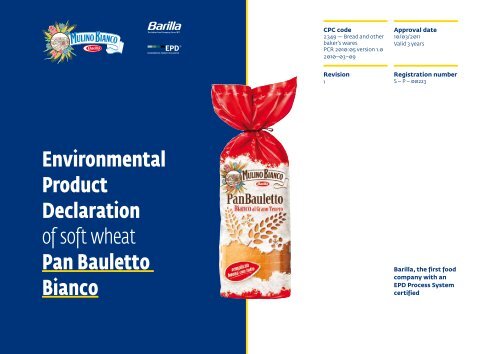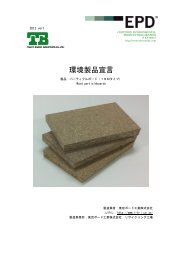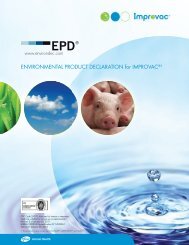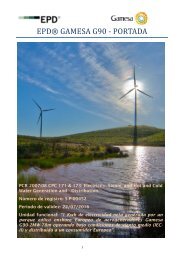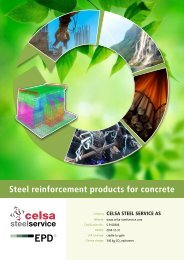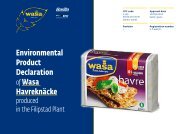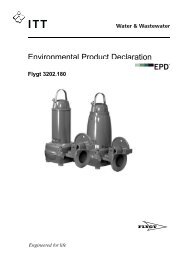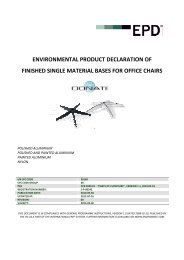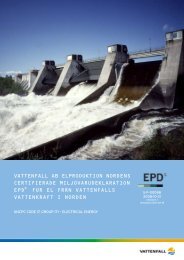Environmental Product Declaration of soft wheat Pan Bauletto Bianco
Environmental Product Declaration of soft wheat Pan Bauletto Bianco
Environmental Product Declaration of soft wheat Pan Bauletto Bianco
Create successful ePaper yourself
Turn your PDF publications into a flip-book with our unique Google optimized e-Paper software.
CPC code<br />
2349 — Bread and other<br />
baker's wares<br />
PCR 2010:05 version 1.0<br />
2010–03–09<br />
Approval date<br />
10/03/2011<br />
Valid 3 years<br />
Revision<br />
1<br />
Registration number<br />
S – P – 00223<br />
<strong>Environmental</strong><br />
<strong>Product</strong><br />
<strong>Declaration</strong><br />
<strong>of</strong> s<strong>of</strong>t <strong>wheat</strong><br />
<strong>Pan</strong> <strong>Bauletto</strong><br />
<strong>Bianco</strong><br />
Barilla, the first food<br />
company with an<br />
EPD Process System<br />
certified
01.<br />
the brand mulino bianco<br />
Established in 1975, it <strong>of</strong>fers a varied range<br />
<strong>of</strong> simple, genuine bakery products for easy<br />
consumption both at home and away.<br />
It represents part <strong>of</strong> Italian food culture<br />
in everyday family life.<br />
Plant and process<br />
<strong>Pan</strong> <strong>Bauletto</strong> <strong>Bianco</strong>, a type <strong>of</strong> bread, is produced<br />
in an two Italian plants (Cremona<br />
and Melfi), where a typical bakery process<br />
takes place. The process steps involved in<br />
the manufacture <strong>of</strong> bread are: mixing ingredients<br />
(flour, water, salt and yeast) to form a<br />
dough; bulk fermentation; division <strong>of</strong> dough<br />
into individual loaf-sized pieces; moulding,<br />
pro<strong>of</strong>ing and baking <strong>of</strong> pieces in specific gas<br />
oven; cooling and packaging.<br />
<strong>Pan</strong> <strong>Bauletto</strong> <strong>Bianco</strong> is packed into 400<br />
grams format. The product does not need to<br />
be cooked, it is ready for consumption.<br />
product content<br />
the product<br />
More info on www.mulinobianco.it<br />
nutritional information<br />
Energy kcal 360<br />
proteins<br />
grams<br />
63<br />
s<strong>of</strong>t <strong>wheat</strong> flour 59%<br />
Carbohydrates<br />
grams<br />
12<br />
water<br />
28%<br />
Fats<br />
grams<br />
7,0<br />
Brand<br />
yeast<br />
vegetable oils<br />
5%<br />
4%<br />
Of which saturated fats<br />
fibres<br />
grams<br />
grams<br />
3,0<br />
11<br />
and <strong>Product</strong><br />
salt & others<br />
4%<br />
Sodium<br />
grams<br />
0,6<br />
|<br />
EPD <strong>Pan</strong> <strong>Bauletto</strong> <strong>Bianco</strong>, 10/03/2011 | 2
02.<br />
Barilla Group<br />
The Group dates back to 1877, from the pasta<br />
and bread boutique in the centre <strong>of</strong> Parma<br />
(Italy), owned by Pietro Barilla. Since then,<br />
progress has always come under a guiding<br />
hand, with exception from the period between<br />
1971 and 1979, through a passing <strong>of</strong><br />
generations from father to son.<br />
Barilla today stands as one <strong>of</strong> the top<br />
Italian food groups, leading company in<br />
the pasta market around the world, the processed<br />
sauce market <strong>of</strong> continental Europe,<br />
and the flatbread market in Scandinavia.<br />
The Group, that is now driven by the three<br />
brothers Guido, Luca and Paolo, employs a<br />
workforce <strong>of</strong> over 15.000 people and has an<br />
annual turnover <strong>of</strong> 4,1 billion euro in 49 production<br />
plants (14 in Italy and 35 abroad),<br />
including 9 mills that provide the majority<br />
<strong>of</strong> raw materials required for the Group’s<br />
production <strong>of</strong> pasta and oven-baked goods.<br />
<strong>Product</strong>s are exported to over 150 countries:<br />
the plants provide an annual production<br />
<strong>of</strong> nearly 3 million tons <strong>of</strong> foodstuff<br />
that are consumed worldwide under the label<br />
<strong>of</strong> various brands. www.barillagroup.com<br />
The Group’s brands<br />
The Group’s brands fall into two principle<br />
business areas: meal solution and bakery<br />
products. In the Meal Solution section, Barilla<br />
leads the pasta market both in Italy and<br />
worldwide, in which it sells under the Barilla<br />
brand name, symbol <strong>of</strong> Italian gastronomy,<br />
and with lead brands at a local level (Misko in<br />
Greece, Filiz in Turkey and Yemina in Mexico).<br />
In addition, Barilla also claims leadership in<br />
the processed sauce segment, with over 40<br />
different recipes to guarantee the right solution<br />
tailored to the needs <strong>of</strong> a worldwide<br />
market. The area <strong>of</strong> baked goods includes<br />
products that cover the different moments<br />
<strong>of</strong> consumption, from breakfast meals to<br />
snacks such as: biscuits, toasted bread, cereals,<br />
snacks, confectionery, s<strong>of</strong>t breads, pastries<br />
and snacks, cakes and crispbread for bid<br />
which includes almost 180 products, fruit <strong>of</strong><br />
35 different production technologies.<br />
The product brands are flanked by the<br />
brand Number 1, group company specialized<br />
in logistic services, and First for retail sales<br />
services.<br />
|<br />
EPD <strong>Pan</strong> <strong>Bauletto</strong> <strong>Bianco</strong>, 10/03/2011 | 3
03.<br />
The <strong>Environmental</strong> performance <strong>of</strong> <strong>Pan</strong> — dough formation, bulk fermentation,<br />
<strong>Bauletto</strong> <strong>Bianco</strong> was calculated using the moulding, pro<strong>of</strong>ing;<br />
LCA (life cycle analysis) methodology, — baking <strong>of</strong> pieces in tunnel gas oven;<br />
including the entire production chain, starting<br />
from the cultivation <strong>of</strong> the raw materials — production <strong>of</strong> packaging material;<br />
— cooling and packaging <strong>of</strong> <strong>Pan</strong> <strong>Bauletto</strong>;<br />
until the delivery <strong>of</strong> the finished product to — delivery <strong>of</strong> products to distribution<br />
main distribution platforms.<br />
platforms.<br />
The study was conducted following the<br />
specific product rules published for the EPD Downstream processes that include, use<br />
system: “CPC code 2349 – Bread and other phase general and indicative information,<br />
bakers’ wares”.<br />
waste disposal processes <strong>of</strong> primary packaging.<br />
These processes are not included in the<br />
The general data contributes to the calculation<br />
<strong>of</strong> environmental impacts that stands system boundaries.<br />
at less than 10%.<br />
declared unit<br />
Data are referred to 1 kg <strong>of</strong> product.<br />
upstream<br />
processes<br />
<strong>Product</strong>ion<br />
<strong>of</strong> ingredients<br />
System boundaries<br />
The processes constituting the system analyzed<br />
were organized according to following<br />
three successive phases, in compliance with<br />
the requisites <strong>of</strong> the EPD system:<br />
process<br />
<strong>Environmental</strong><br />
Impact<br />
Calculation<br />
Upstream processes that include:<br />
— cultivation and processing <strong>of</strong> raw<br />
material (flour, yeast, vegetable oil);<br />
— production <strong>of</strong> fertilizer and other<br />
substances used for agricultural<br />
processes;<br />
— transport <strong>of</strong> raw material to the<br />
production plant.<br />
Core process that include:<br />
— mixing <strong>of</strong> raw ingredients;<br />
core<br />
processes<br />
downstream<br />
processes<br />
Packaging<br />
Distribution<br />
packaging<br />
end <strong>of</strong> life<br />
|<br />
EPD <strong>Pan</strong> <strong>Bauletto</strong> <strong>Bianco</strong>, 10/03/2011 | 4
General<br />
hypotheses<br />
adopted<br />
Here the main relevant hypotheses are presented.<br />
1. raw materials<br />
Cereals cultivation impacts have been calculated on the<br />
basis <strong>of</strong> primary data (yield and fertilizers use) collected<br />
from farmers integrated with secondary data collected<br />
mainly from Ecoinvent (www.ecoinvent.ch).<br />
Cultivation yield are referred to 2009 production.<br />
Data from public database (Ecoinvent) are used for<br />
other raw material in <strong>Pan</strong> <strong>Bauletto</strong> recipe (vegetable<br />
oil, yeast).<br />
2. <strong>Product</strong>ion process<br />
Bakery environmental impacts are calculated<br />
considering electricity and natural gas consumption by<br />
the oven. They are calculted using specific natural gas<br />
consumption for the product and a mass allocation*<br />
for other environmental aspects.<br />
Cremona and Melfi plants are considered in the<br />
analysis. Contribution <strong>of</strong> each plant to environmental<br />
aspectc is based on 2009 overall <strong>Pan</strong> <strong>Bauletto</strong><br />
production. Primary data (2009 year) are used<br />
for energy and water consumption and for waste<br />
production; secondary data (ecoinvent database) are<br />
used for energy and water production.<br />
5. pack End <strong>of</strong> life<br />
<strong>Environmental</strong> impacts related to waste disposal <strong>of</strong><br />
packaging are out <strong>of</strong> the boundaries because they<br />
depend on the consumer habits and organization <strong>of</strong><br />
waste collection services.<br />
4. distribution<br />
Distribution impacts are calculated using considering<br />
100% <strong>of</strong> production delivered in Italy by truck.<br />
The product does not need any particular storage<br />
condition (such as refrigeration).<br />
3. Packaging<br />
<strong>Environmental</strong> impacts are calculated taking into<br />
account 400 grams format.<br />
Primary data (from Barilla packaging unit) are used<br />
for packaging amount and secondary data (ecoinvent<br />
database) for packaging material production.<br />
* PCR requires for economic allocation but the mass allocation is applied as better criterium according to ISO 14044 §4.3.4 (the updating PCR has been submitted to technical committee).<br />
|<br />
EPD <strong>Pan</strong> <strong>Bauletto</strong> <strong>Bianco</strong>, 10/03/2011 | 5
04.<br />
<strong>Environmental</strong><br />
Results<br />
non renewable<br />
resources<br />
Material<br />
resources<br />
— data in grams<br />
Energy<br />
resources<br />
— data in grams<br />
renewable resources<br />
— data per 1 kg <strong>of</strong> product<br />
Energy<br />
resources<br />
— data in MJ<br />
upstream<br />
processes<br />
Raw materials<br />
cultivation<br />
upstream<br />
processes<br />
Process<br />
core processes<br />
Packaging<br />
core processes<br />
Distribution<br />
Total Total<br />
Gravel 0,30 0,50 22,11 0,00 22,91<br />
Sodium Chloride<br />
Limestone (CaCO₃)<br />
Potassium chloride<br />
Titanium oxides<br />
Others<br />
Coal<br />
Oil<br />
Natural gas<br />
Uranium<br />
Others<br />
Hydroelectric<br />
Wind<br />
Solar<br />
18,21 2,27 1,54 0,00 12,02<br />
4,80 1,65 1,90 0,01 8,36<br />
6,00 0,04 0,13 0,00 6,17<br />
0,00 0,00 2,63 0,00 2,63<br />
3,05 0,22 0,91 0,00 4,18<br />
15,4 32,9 24,6 0,4 73,3<br />
66,9 9,4 32,4 17,8 126,5<br />
34,8<br />
0,0<br />
0,0<br />
Raw materials<br />
cultivation<br />
97,7 39,2 0,9 172,6<br />
0,0 0,0 0,0 0,0<br />
0,0 0,3 0,0 0,3<br />
Process<br />
Packaging<br />
Distribution<br />
0,10 0,61 0,06 0,00<br />
0,00 0,07 0,00 0,00<br />
0,00 0,02 0,00 0,00<br />
0,77<br />
0,07<br />
0,02<br />
|<br />
EPD <strong>Pan</strong> <strong>Bauletto</strong> <strong>Bianco</strong>, 10/03/2011 | 6
fresh water consumption<br />
— data in litres<br />
impact indicators<br />
— for GWP values<br />
see Carbon Footprint<br />
Ozone-depleting potential<br />
Ozone-creating potential<br />
Acidification potential<br />
Eutrophication potential<br />
Per 1 kg <strong>of</strong> product<br />
mg CFC11 equivalent<br />
g C₂H₄ equivalent<br />
g SO₂ equivalent<br />
g PO₄−−− equivalent<br />
Waste per 1 kg <strong>of</strong> product *<br />
upstream<br />
processes<br />
Raw materials<br />
cultivation<br />
16,4<br />
upstream<br />
processes<br />
Raw materials<br />
cultivation<br />
0,042<br />
0,46<br />
5,0<br />
3,2<br />
upstream<br />
processes<br />
Raw materials<br />
cultivation<br />
Process<br />
5,7<br />
Process<br />
0,063<br />
0,22<br />
0,8<br />
0,1<br />
Process<br />
core processes<br />
Packaging<br />
2,7<br />
core processes<br />
Packaging<br />
0,017<br />
0,08<br />
0,7<br />
0,1<br />
core processes<br />
Packaging<br />
Distribution<br />
0,1<br />
Distribution<br />
0,007<br />
0,04<br />
0,3<br />
0,1<br />
Distribution<br />
Total Total Total<br />
24,9<br />
0,129<br />
0,80<br />
6,8<br />
3,5<br />
Haxardous<br />
0,00<br />
0,00<br />
0,00<br />
0,00<br />
0,00<br />
Not hazardous<br />
0,70<br />
0,10<br />
0,00<br />
0,00<br />
0,80<br />
* Only the primary data on wastes are reported as mass, the secondary data are calculated as a contribution on environmental burdens.<br />
|<br />
EPD <strong>Pan</strong> <strong>Bauletto</strong> <strong>Bianco</strong>, 10/03/2011 | 7
product footprint<br />
Additional indicators in the form <strong>of</strong> water and ecological footprint,<br />
calculated on the basis <strong>of</strong> indications provided herein, were employed<br />
to determine all relative impacts.<br />
<strong>Pan</strong><br />
<strong>Bauletto</strong><br />
<strong>Bianco</strong><br />
Raw materials<br />
cultivation<br />
Process<br />
Packaging<br />
Distribution<br />
From field<br />
to Distribution<br />
Ecological Footprint<br />
5,4<br />
1,1<br />
1,0<br />
0,2<br />
7,7<br />
global m²/kg<br />
Carbon Footprint<br />
GWP<br />
588<br />
395<br />
189<br />
61<br />
1.233<br />
g CO₂eq/kg<br />
Water Footprint<br />
560<br />
6<br />
3<br />
packaging end <strong>of</strong> life<br />
Primary packaging composed by plastic flexible film is<br />
recyclable. It is recommended to send this type <strong>of</strong> packaging<br />
to differentiated urban waste.<br />
To help the consumer in the disposal phase, every Ba-<br />
rilla primary packaging contains an icon that states the<br />
packaging material suggestion for proper disposal.<br />
Secondary packaging (paperboard box used for product<br />
transport) has to be sent to a recyclable circuit managed<br />
by retailers.<br />
In the Italian<br />
context<br />
the plastic<br />
flexible<br />
films from<br />
differentiated<br />
waste are<br />
usually<br />
sent to<br />
Dump<br />
energy<br />
recovery<br />
56% <strong>of</strong> the total amount <strong>of</strong> film produced in Italy<br />
Elaboration <strong>of</strong> CONAI data<br />
<strong>Environmental</strong> performance <strong>of</strong> dump is due mainly to its<br />
management that causes the production <strong>of</strong> biogas and<br />
leachate. Packaging treatment <strong>of</strong> 1 unit (400 grams format)<br />
<strong>of</strong> <strong>Pan</strong> <strong>Bauletto</strong> may cause the emission <strong>of</strong> about 1 gram <strong>of</strong><br />
CO₂eq.<br />
34% <strong>of</strong> the total amount <strong>of</strong> film produced in Italy<br />
Elaboration <strong>of</strong> CONAI data<br />
In this way product energy content may be recovered (about<br />
0,5 MJ per unit).<br />
recycle<br />
10% <strong>of</strong> the total amount <strong>of</strong> film produced in Italy<br />
Elaboration <strong>of</strong> CONAI data<br />
It allows to avoid the production <strong>of</strong> virgin polymer.<br />
|<br />
EPD <strong>Pan</strong> <strong>Bauletto</strong> <strong>Bianco</strong>, 10/03/2011 | 9
05.<br />
Additional<br />
Information<br />
<strong>Environmental</strong> declarations published within<br />
the same product category, though originating<br />
from different programs, may not be<br />
comparable.<br />
This declaration and further information in<br />
regards are available at www.environdec.com<br />
References<br />
Here the most important references are<br />
indicated. In the support document further<br />
details are available:<br />
— International EPD Consortium; General<br />
Programme Instructions (EPD); ver. 1 <strong>of</strong><br />
29/02/2008;<br />
— WWF, Global Footprint Network,<br />
Zoological Society <strong>of</strong> London; Living<br />
Planet Report 2008, WWF (2008);<br />
— Arjen Y. Hoekstra, Ashok K. Chapagain,<br />
Maite M. Aldaya, Mesfin M. Mekonnen;<br />
Water Footprint Manual State <strong>of</strong> the Art<br />
2009, Waterfootprint Network;<br />
— PCR 2010: 05; CPC 2349: Bread and Other<br />
Bakers' Wares; ver. 1.0 <strong>of</strong> 09/03/2010;<br />
— Process Certification Clarification (PCC)<br />
for the International EPD System; ver. 1.0<br />
<strong>of</strong> 23/04/2010;<br />
— Process Certification Clarification<br />
(PCC) for the International EPD System;<br />
Guidelines; ver. 1.0 <strong>of</strong> 23/04/2010.<br />
This EPD have been internally verified among a certified<br />
EPD process.<br />
epd process certification<br />
PCR review conducted by:<br />
Technical Committee<br />
<strong>of</strong> the International EPD® system<br />
Verifier:<br />
Maurizio Fieschi<br />
Third party verifier:<br />
Bureau Veritas<br />
(accreditation number for EPD: 1236)<br />
Contacts<br />
For additional information relative to the activities<br />
<strong>of</strong> the Barilla Group or in regards to this environmental<br />
declaration, please contact:<br />
Luca Ruini — ✉ luca.ruini@barilla.com<br />
Technical support<br />
Life Cycle Engineering (Italy)<br />
— www.studiolce.it<br />
Graphic Design<br />
Fabio Gioia — www.fabiogioia.com<br />
|<br />
EPD <strong>Pan</strong> <strong>Bauletto</strong> <strong>Bianco</strong>, 10/03/2011 | 10
06.<br />
Ecological Footprint<br />
www.globalfootprint.org<br />
The Ecological Footprint measures the area <strong>of</strong> biologically productive<br />
land and water required to provide the resources used and absorb<br />
the carbon dioxide waste generated by human activity, under<br />
current technology, by tracking flows <strong>of</strong> resources and carbon emissions<br />
on annual basis. It is measured in standard units called global<br />
hectares (GHA).<br />
The calcultaion methodology was developed by the Global Footprint<br />
Network.<br />
Carbon Footprint<br />
The product carbon footprint is a measure <strong>of</strong> potential contribution<br />
to climate change due to the amount <strong>of</strong> greenhouse gases (GHG)<br />
released by production chain processes.<br />
This contribution, global warming potential (GWP), is measured<br />
in terms <strong>of</strong> mass <strong>of</strong> CO₂ equivalent and is calculated by multiplying<br />
the specific GHG emissions (mainly CO₂, N₂O, CH₄) by the specific<br />
conversion factors defined by the IPCC (www.ipcc.ch).<br />
Many protocols are available for its calculation.<br />
Glossary<br />
Water Footprint<br />
www.waterfootprint.org<br />
The water footprint <strong>of</strong> a product is the volume <strong>of</strong> freshwater used to<br />
produce the product, measured over the full supply chain.<br />
It is a multi-dimensional indicator, showing water consumption<br />
volumes by source and polluted volumes by type <strong>of</strong> pollution; all<br />
components <strong>of</strong> a total water footprint are specified geographically<br />
and temporally.<br />
The calculation methodology was developed by the Water Footprint<br />
Network.<br />
|<br />
EPD <strong>Pan</strong> <strong>Bauletto</strong> <strong>Bianco</strong>, 10/03/2011 | 11
Acidification Potential<br />
(AP)<br />
Phenomenon by which atmospheric rainfall has a pH value below<br />
the normal average. It can provoke damage to forests and agriculture,<br />
as well as to aquatic ecosystems and manmade structures. It is<br />
the result <strong>of</strong> SO₂, <strong>of</strong> NOx, and NH₃, that are included in the Acidification<br />
Potential indicator (AP) expressed in moles <strong>of</strong> H+ produced.<br />
Eutrophication Potential<br />
(EP)<br />
Nutrient enrichment <strong>of</strong> flowing water bodies, which determines<br />
unbalance in aquatic ecosystems due to excessive flourishing caused<br />
by lack <strong>of</strong> nutrient limitation. The Eutrophication potential (EP)<br />
especially includes phosphate and nitrogen salts, and is expressed<br />
as grams <strong>of</strong> oxygen equivalent (g O₂).<br />
Ozone Depletion Potential<br />
(ODP)<br />
Degradation <strong>of</strong> the stratospheric layer <strong>of</strong> the ozone involved in blocking<br />
the UV component <strong>of</strong> sunrays. Depletion is due to particularly<br />
reactive components that originate from chlor<strong>of</strong>luorocarbon (CFC)<br />
or chlor<strong>of</strong>luoromethanes (CFM). The substance employed as benchmark<br />
measure for OPD is trichlor<strong>of</strong>luoromethane, or CFC-11.<br />
Photochemical Ozone Creation Potential<br />
(POCP)<br />
<strong>Product</strong>ion <strong>of</strong> compounds that foster oxidation due to interaction<br />
with light, resulting in ozone formation in the troposphere. The<br />
POCP indicator mostly encompasses VOC (volatile organic compounds)<br />
and is expressed as grams <strong>of</strong> ethylene equivalent (g C₂H₄).<br />
|<br />
EPD <strong>Pan</strong> <strong>Bauletto</strong> <strong>Bianco</strong>, 10/03/2011 | 12


